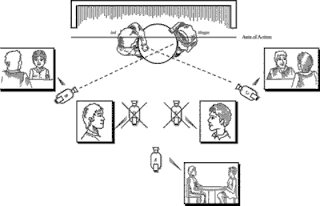There is no a doubt several conversations in every single film that has ever been produced. Because of the fact conversation within a film is inevitable it can mean for repetitive, boring scenes.
Directors continue to capture the interest of consumers when filming these -some what boring- scenes by adding interesting and varied shots and angles. They ensure they capture certain clips that prompt consumers to have an opinion and evoke particular emotions.
Common shots used when shooting a conversation:
-2 mid shots (often over the shoulder and from several distances)
-A wide shot that tends to show all characters (this is usually the master shot throughout the scene)
-Close ups/Birds eye (commonly used for pick ups)
When shooting a conversation in a lower budget film often only one camera is used. Four takes would need to be shot:
1) Master shot
2) Character 1 MS
3) Character 2 MS
4) Pick ups
This would take quite a while edit. Whereas a film with a bigger budget tends to only use two cameras when shooting a conversation:
1) Master shot + Pick ups
2) Character 1 MS/ Character 2 MS
The less camera's required on set, usually, the better the scene for this would increase editing time and continuity ultimately resulting in a more fluent scene.
In most films, when shooting a conversation there will be close ups and cutaway shots of significant objects or expressions. For example, in this clip of The Hunger Games there was a cutaway showing a high angle shot of 'Prim' passing the protagonist a pendent. This makes the consumer remember the pendent and assume that this object has some significance and makes us question why? It also makes the conversation scene more visually interesting.
Close ups are also very useful when trying to add emotion to the conversation. Whether the emotion is sadness, anger or fear a close up of a characters , can be so powerful in getting that emotion across without using any dialog.
Shot/reverse shot is a film technique used constantly when filming a conversation...
wherein one character is shown looking (often off-screen) at another character, and then the other character is shown looking "back" at the first character. Since the characters are shown facing in opposite directions, the viewer unconsciously assumes that they are looking at each other.
 The shots used when filming a basic shot/reverse shot are establishing shots of the two characters, either a wide shot or mid shot. This differentiates the two characters and if needs be can clearly show the antagonist and the protagonist.
The shots used when filming a basic shot/reverse shot are establishing shots of the two characters, either a wide shot or mid shot. This differentiates the two characters and if needs be can clearly show the antagonist and the protagonist.The other shot, an over the shoulder shot of each character. This way the consumer can see that the two characters are talking to one another.
This clip is a clear example of shot/reverse shot.
One of the most basic continuity rules is the 180 degree rule. Though, just because there are 'rule' when film making it does not necessitate that one should follow them. In fact a lot of directors tend not to (e.g Tarantino). However, there is a huge difference in consciously breaking the rule for a purpose and breaking the rule because you are an inexperienced film maker. If not done correctly, breaking the 180 degree rule can make for an amateur-like, confusing scene or film.
So, unless you are a very well established and creative director, it is a rule advised to follow at all times. When shooting a conversation it is important to set the scene and establish your characters in order for viewers to follow the conversation. Use of the 180 degree rule makes the scene seem more realistic and ensures that audiences do not get confused of the characters positioning in the scene. The is especially essential if the conversation is serious and needs to be carefully listened to and followed.
Sound and lighting can make a massive impact on a scene. Light connotations often evoke thoughts and feelings, and can determine the mood of the scene. Lighting can also put emphasis on certain characters/objects within the scene for example...
In this scene of Casino Royale Bond is wearing all black and is sitting with the lights turned off, the lighting coming in from the window is shinning on James' face. We cannot see the rest of his body, just his face. This use of lighting makes the whole scene feel enigmatic, and keeps viewers on edge, because we cannot clearly see what his hands or the rest of his body is doing so what will happen next is unknown.
Sometimes sound is played over the top of a conversation. Often to add to the sadness or drama of the scene and determine the pace of the scene. This can be very effective in a slow, sad scene because it can really consume the viewer and encourage emotion or feeling. Alternatively sound in a more fast paced, scary scene can also be very useful in building up to a climax (just think, without that all important sound clip every time something bad was about to happen in Jaws, no one would know what was going on!)
However, sometimes certain music can be distracting and can take away from the seriousness of a conversation or a scene sometimes resulting in an anti-climax.




No comments:
Post a Comment